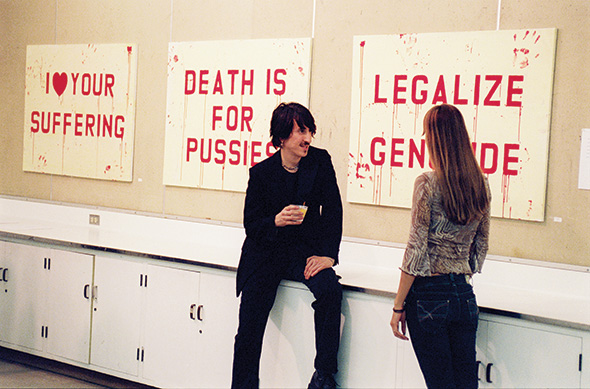
Text by Steven Snyder
He has created worlds this unusual before – lairs of the bizarre, the wacky, the cynical and the angry. But director Terry Zwigoff has never before filmed his dreamscapes from the eyes of someone who didn’t embrace the low-key, low-energy and low-brow ways standard in Zwigoff’s films.
Just consider his repertoire. In Crumb, he chronicles the life of famous comic-book artist R. Crumb, who maintains his tenuous grasp on reality with the help of his art. In Ghost World, he outlined the world of loneliness and solitude that overwhelms both a young, out-of-place high schooler and an older, out-of-sync record collector. In Bad Santa, Zwigoff crafted a holiday comedy around the least cheerful person (an alcoholic) and place (a strip mall) imaginable. And in Art School Confidential, set for release in late April, many of the same Zwigoff-staples resurface. Yet there’s something unmistakably different about this spin around a familiar block, and Zwigoff seems to recognize the difference, even if he can’t give it a name.
“As I was shooting and editing the film, I thought it was a rather straightforward, conventional picture,” he says in response to criticisms lodged in a Variety review that the film’s script can’t decide what it wants to be about. “Then I watched it six months later at the premiere and found it to be a rather odd, eccentric film. I never thought of the film as elusive or enigmatic. It probably just means my skills as a storyteller are horribly impaired.”
The key difference this time around is that this story’s hero is not a member of Zwigoff’s world. Unlike the vapid suburban squalor of Ghost World’s Los Angeles or the mind-numbing artificiality of Bad Santa’s department stores, Art School Confidential approaches specialized art schools from the vantage of an aspiring painter who is excited to take the world by storm. No, he doesn’t quite fit in, but he genuinely tries his hardest to be the best student he can be. Thus Art School seems strangely un-Zwigoffian, constructed amid a dysfunctional world but around a completely sane and well-meaning teenage idealist.
Only in hindsight do we realize this approach is in fact more challenging than Zwigoff’s prior stories. In most of his works, he embraces characters who to some degree wallow in their bitter, angry or even pathetic lives. But in Art School, something’s different. Jerome (Max Minghella) is not bitter about school, but hopeful and optimistic, and the movie is instead about him being repeatedly beaten down: first by Audrey (Sophia Myles), a beautiful young model who tosses his affections aside; by Professor Sandiford (John Malkovich), a down-and-out teacher who doesn’t care much for his style; and by Jimmy (Jim Broadbent), an art school alum who now lives as a drunk, holed up like a hermit in his apartment. To make matters worse, a mysterious murderer known as the Strangler is killing students around campus every day.
Based on the comic strip by Daniel Clowes – the same writer Zwigoff collaborated with on Ghost World – the director admitted he is most interested in films that don’t follow the traditional formulas. “I’m my own worst enemy. I can’t help myself. Believe me, my life would be easier if I could be happy tackling the latest star-driven, by-the-numbers romantic comedy.”
But his love for unusual and unconventional stories is precisely why he has attracted such a passionate fan base. In this film, he throws conventional genres and motifs to the wind and starts from scratch. Art School Confidential is at once funny, optimistic, painful and downright bleak, and Zwigoff attributes the film’s successful merging of comedy, melodrama, satire and suspense to the cast that worked together on the film. And with Minghella in place to play the ideal artist who becomes increasingly disillusioned and disheartened, his essential performance benefited from a collaborative environment that allowed the young actor to learn from such thespians as Malkovich, Broadbent, Angelica Huston and dozens of others who bring to life the many personalities of the art school.
However he most striking and unusual character of the film might be the one who is never even seen – the Strangler. “Appearing” onscreen once – and from a first-person perspective, no less – Zwigoff said he welcomed the Strangler subplot and the film’s unusual turn from comedy to crime caper. “I never found the [murder] scene disturbing, maybe because shooting it was certainly the most fun I ever had on a film set. I think I did 42 setups in one night – it was so much fun for me that I think the rest of the crew and the producers were a bit worried watching me that night.
“Maybe I should be making horror films,” he confides. “All I can tell you is that dying is easy and comedy is hard. It was a relief to not have to try and be funny for a change.”

